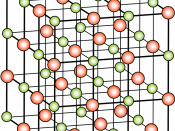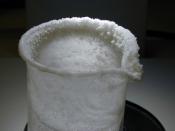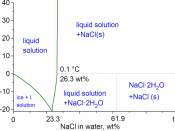2. Abstract
We weight the educts and products while we did the experiment, that we can see how the chemical equation is balanced.
3. Introduction
We mixed Na(2)CO(3) and HCl together. The reaction began and the product CO(2) came out as a gas. The residue was NaCl + H(2)O.
4. Procedure
We put Na(2)CO(3) on the one side of the glass and the HCl(aq) on the other side. Then we took the funnel and stuck it in a rubber and put both in the glass that no gas comes out. Then we took the cylinder and filled it up with water and put it upside down in a beaker full of water. There should be no gas in the cylinder! Now we shaked the glass with the two substances and the reaction began. There came bubbles (CO(2)) gas which went into the cylinder. Then we calculated the volume of gas in the cylinder.
The water was sided out after one day in the baker and we could also calculate how much water and NaCl in the residue was left.
5. Look on the paper behind.
6. 1) Na(2)CO(3) + 2HCl = 2CO(2) + NaCl + H(2)O
2) Mass of Na(2)CO(3): 4.02g, 105.988g/mole
Molar Mass of NaCl: 58.443g/mole
Mole Na(2)CO(3), 4.02g:105.988g/mole=0.0379mole
Mass of NaCl: 0.0379x58.443g/mole=2.215gx2= 4.43g
3) Entire Mass: 5.05g
NaCl: 86.65%
H(2)O: 13.35%
5.05gx0.8665= 4.375g
4) difference= (4.43g-4.375g):(4.43g)x100
difference= 1.24%
5) Mol Na(2)CO(3) 4.02g:105.988g/mole=0.0379mole
22.4l/molex0.0379mole= 0.849liters of gas.
6) 680ml
7) difference=(849ml-680ml):849=0.199x100= 19.9%
7. Conclusion
I learned how to balance a chemical equation in an experiment. I also saw that the measured and calculated mass by gases very different is, because we will lose all the time a lot gas.


